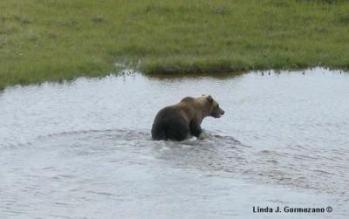Two of the world’s largest land carnivores are converging on the same territory, according to data recently published in Canadian Field Naturalist. Grizzly bears ( Ursus arctos horribilis) are moving into an area that has long been considered prime polar bear habitat in Manitoba, Canada. Although polar bears (Ursus maritimus) are bigger than their grizzly relatives—they are the world’s largest land carnivores—biologists are concerned that grizzlies will kill polar cubs, further threatening the polar bear, which is already thought to be imperiled by ice loss in the Arctic.
“Grizzly bears are a new guy on the scene, competition and a potential predator for the polar bears that live in this area,” says Robert F. Rockwell, a research associate at the Museum and a professor of Biology at CUNY. “The first time we saw a grizzly we were flying over the middle of [Wapusk National Park], counting fox dens, when all of the sudden Linda Gormezano, a graduate student working with Rockwell and a co-author of the paper, shouted ‘Over there, over there—a grizzly bear.’ And it wasn’t a dirty polar bear or a moose—we saw the hump.”
 This is a grizzly Bear (Ursus arctos), photographed in Wapusk National Park, Manitoba, Canada, on August 9, 2008. Photo by: Linda Gormezano. |
Researchers say there has been no evidence of grizzlies in the region before 1996. They even scoured hundred of years of trapping data from the Hudson Bay Company and found nothing. Yet, between 1996 and 2008 there have been nine confirmed sightings of grizzlies with three additional sightings last summer.
“This is worrying for the polar bears because grizzly bears would likely hibernate in polar bear maternity denning habitat. They would come out of hibernation at the same time and can kill polar cubs,” said Gormezano.
Before the sightings, researchers had assumed that grizzlies would be unable to pass the barren landscape north of the Hudson Bay. But now that they have passed that gap, they are in an area sporting caribou, moose, fish, and berries.
“We don’t yet know if they are wandering or staying—the proof will come from an observed den or cubs—these animals will eventually be residents of this national park,” says Rockwell. “The Cree elders we talked to feel that now that grizzly bears have found this food source they will be staying.”
The researchers did not say whether they believed this novel grizzly migration was made possible in part because of climate change.
Related articles
U.S. to ban oil drilling in new Arctic reserves for polar bears
(10/07/2008) The U.S. Department of the Interior will designate two Arctic reserves in areas considered critical habitat for polar bears as part of a legal settlement with environmental groups, reports Reuters. The reserves will be off-limits of oil development and must be established by June 30, 2010.
U.S. lists the polar bear as threatened, but decision won’t affect emissions rules
(05/14/2008) The U.S. Interior Department has decided to list the polar bear as a threatened species due to declining sea ice cover in the Arctic, according to the The Associated Press. Interior Secretary Dirk Kempthorne has scheduled a news conference Wednesday to announce the action.
Two-thirds of polar bears at risk of extinction by 2050
(09/07/2007) Two-thirds the world’s polar bears could be threatened with extinction by 2050 due to melting sea ice, said U.S. government scientists Friday. U.S. Geological Survey scientists said that the United States (the north coast of Alaska) and Russian would likely lose all of their polar bear populations. The only bears expected to survive would be those in the northern Canadian Arctic islands and the west coast of Greenland. Overall, bears are forecast to lose 42 percent of the Arctic range they need to hunt and breed during summer months.














